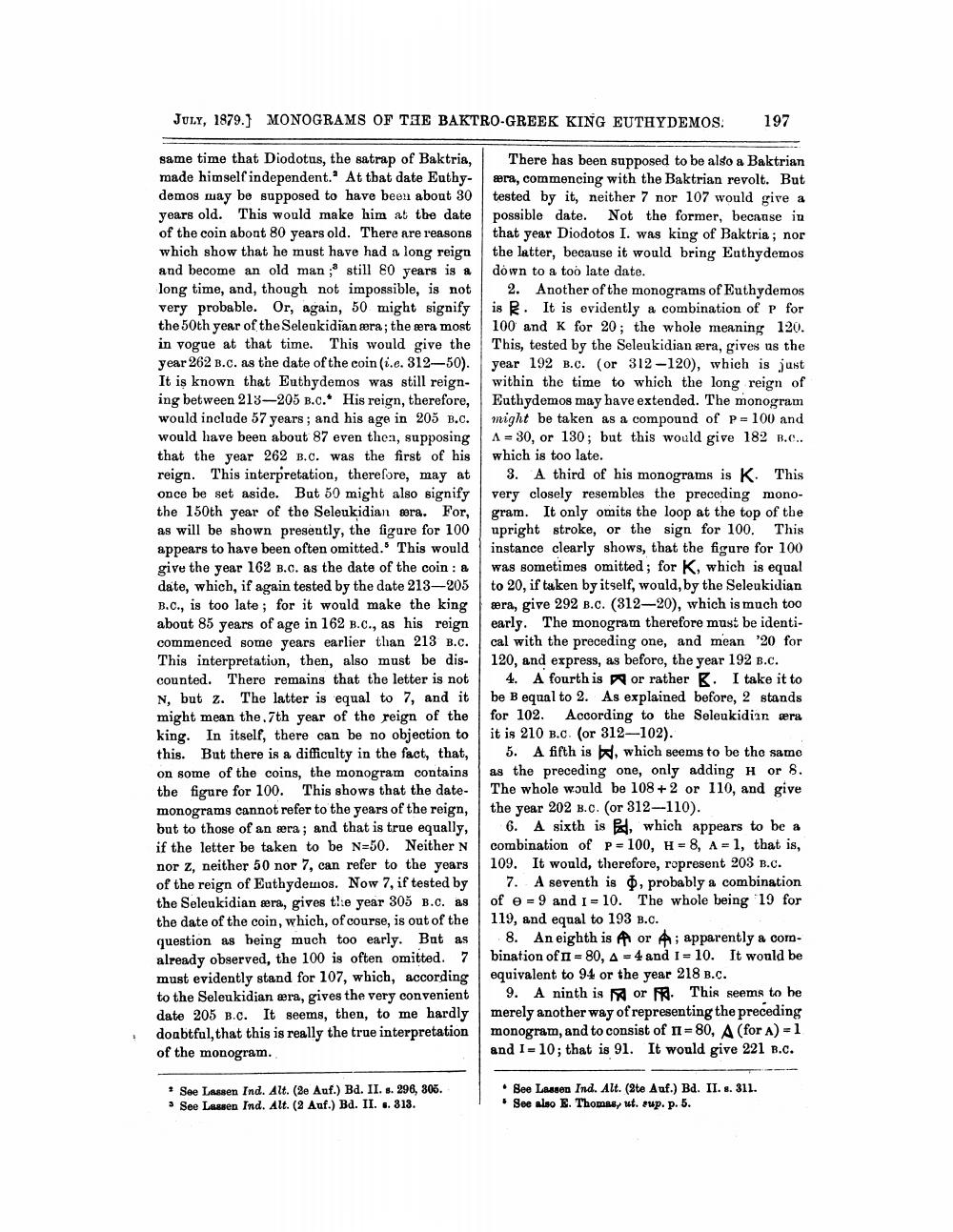________________
JULY, 1879.) MONOGRAMS OF THE BAKTRO-GREEK KING EUTHYDEMOS
197
ne time that Diodotus, the satrap of Baktria, made himself independent. At that date Euthydemos may be supposed to have been about 30 years old. This would make him at the date of the coin abont 80 years old. There are reasons which show that he must have had a long reign and become an old man;" still 80 years is a long time, and, though not impossible, is not 1 very probable. Or, again, 50 might signify the 50th year of the Seleukidianæra; the æra most in vogue at that time. This would give the year 262 B.c. as the date of the coin (i.e. 312—50). It is known that Euthydemos was still reigning between 213-205 B.C.* His reign, therefore, would include 57 years; and his age in 205 B.C. would have been about 87 even thea, supposing that the year 262 s.c. was the first of his reign. This interpretation, therefore, may at once be set aside. But 50 might also signify the 150th year of the Seleukidian era. For, as will be shown presently, the figure for 100 appears to have been often omitted. This would give the year 162 B.C. as the date of the coin: a date, which, if again tested by the date 213-205 B.C., is too late ; for it would make the king about 85 years of age in 162 B.C., as his reign commenced some years earlier than 213 B.C. This interpretation, then, also must be discounted. There remains that the letter is not N, but 2. The latter is equal to 7, and it might mean the 7th year of the reign of the king. In itself, there can be no objection to this. But there is a difficulty in the fact, that, on some of the coins, the monogram contains the figure for 100. This shows that the date monograms cannot refer to the years of the reign, but to those of an era; and that is true equally, if the letter be taken to be N=50. Neither N nor z, neither 50 nor 7, can refer to the years of the reign of Euthydemos. Now 7, if tested by 1 the Seleukidian era, gives the year 305 B.C. as the date of the coin, which, of course, is out of the question as being much too early. But as already observed, the 100 is often omitted. 7 must evidently stand for 107, which, according to the Seleukidian era, gives the very convenient date 205 B.C. It seems, then, to me hardly doubtful, that this is really the true interpretation of the monogram.
There has been supposed to be also a Baktrian æra, commencing with the Baktrian revolt. But tested by it, neither 7 nor 107 would give a possible date. Not the former, because in that year Diodotos I. was king of Baktria; nor the latter, because it would bring Euthydemos down to a too late date.
2. Another of the monograms of Euthydemos is R. It is evidently a combination of p for 100 and K for 20; the whole meaning 120. This, tested by the Seleukidian æra, gives us the year 192 B.c. (or 312-120), which is just within the time to which the long reign of Euthydemos may have extended. The monogram might be taken as a compound of p = 100 and A = 30, or 130; but this would give 182 B.C.. which is too late.
3. A third of his monograms is K. This very closely resembles the preceding monogram. It only omits the loop at the top of the upright stroke, or the sign for 100. This instance clearly shows, that the figure for 100 was sometimes omitted; for K, which is equal to 20, if taken by itself, would, by the Seleukidian wra, give 292 B.C. (312-20), which is much too early. The monogram therefore must be identical with the preceding one, and mean '20 for 120, and express, as before, the year 192 B.C.
4. A fourth is or rather K. I take it to be B equal to 2. As explained before, 2 stands for 102. According to the Seleukidian æra it is 210 B.C. (or 312--102).
5. A fifth is W, which seems to be the same as the preceding one, only adding Hor 8. The whole would be 108 +2 or 110, and give the year 202 s.c. (or 312-110).
6. A sixth is , which appears to be a combination of p= 100, H = 8, A = 1, that is, 109. It would, therefore, ropresent 203 B.C.
7. A seventh is , probably a combination of 0 = 9 and 1= 10. The whole being 19 for 119, and equal to 193 B.C.
8. An eighth is A or A; apparently a combination of II = 80, A-4 and I = 10. It would be equivalent to 94 or the year 218 B.C.
9. A ninth is or . This seems to be merely another way of representing the preceding monogram, and to consist of 11 -80, A (for A) - 1 and I= 10; that is 91. It would give 221 B.C.
* See Lassen Ind. Alt. (2e Auf.) Bd. II. s. 296, 306.
See Lassen Ind. Alt. (2 Auf.) Bd. II. .. 313.
• See Lessen Ind. Alt. (2te Auf.) Bd. II. s. 311.
See also E. Thomas, ut. sup. p. 5.




